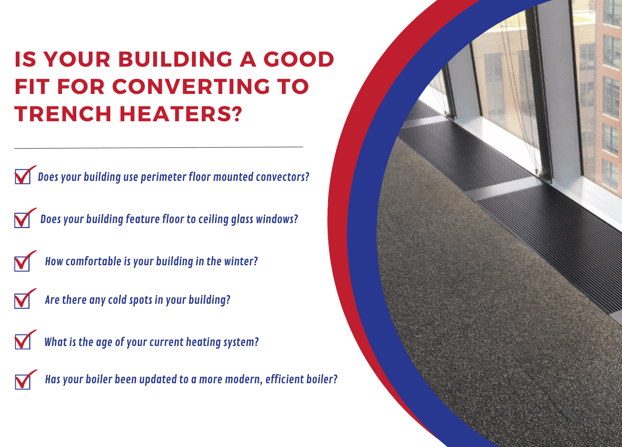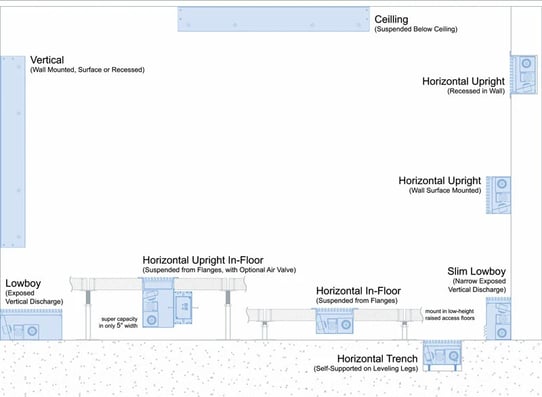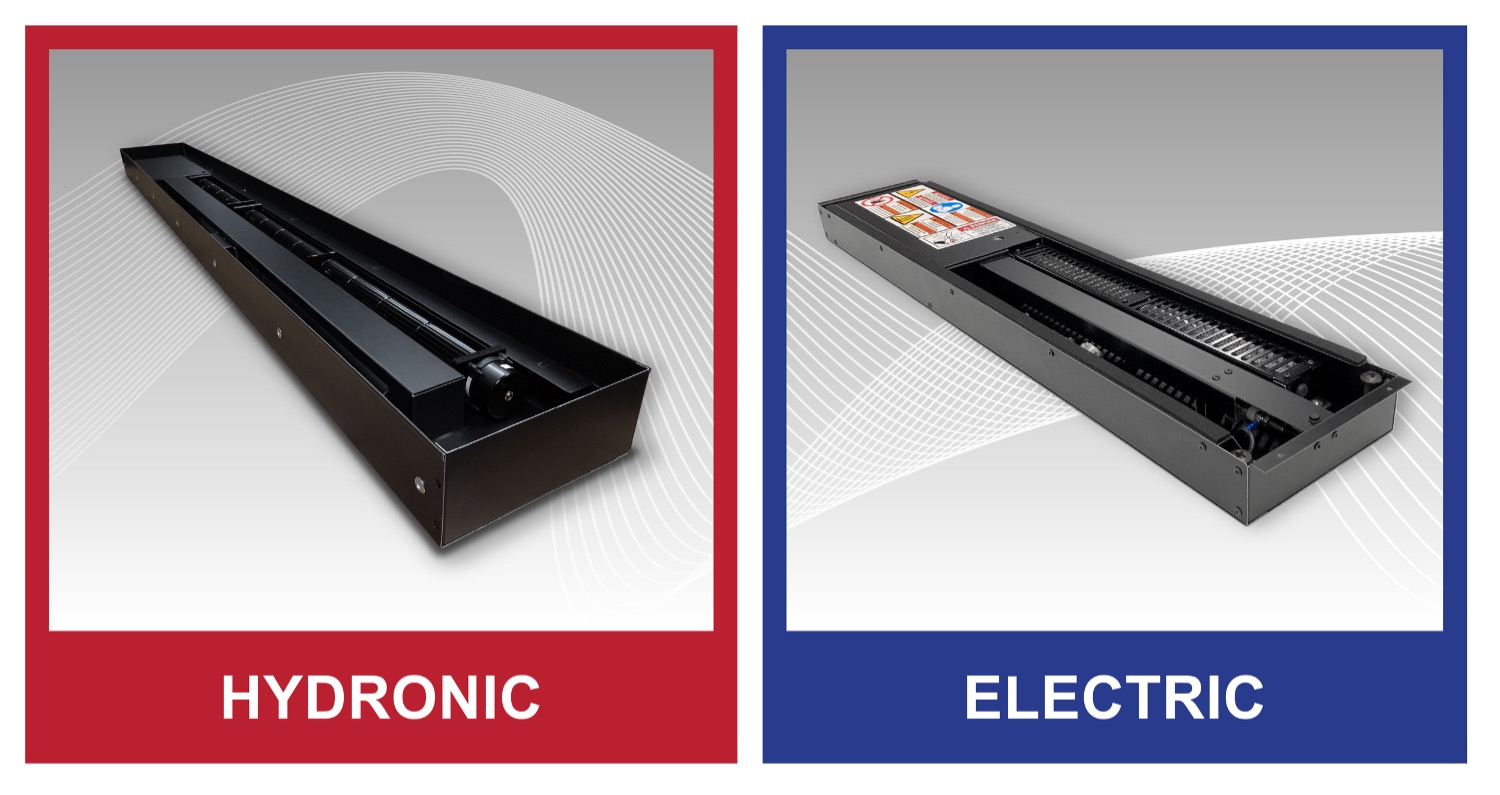How to Install Trench Heaters
Architects, builders and engineers are always looking to push the envelope in their commercial building designs. These unique designs capture...
Floor, wall and ceiling mounted to meet your unique project design.
6 min read
AirFixture : Oct 11, 2023 2:02:56 PM

.jpg?width=305&height=407&name=IMG_6842%20(2).jpg) Building technologies are advancing every day. From smart glass that automatically dims to decrease heat gain from the sun during the day to rainwater collection and recycling, building owners have the unique opportunity to retroactively update their buildings to better fit their unique needs.
Building technologies are advancing every day. From smart glass that automatically dims to decrease heat gain from the sun during the day to rainwater collection and recycling, building owners have the unique opportunity to retroactively update their buildings to better fit their unique needs.
One of the most popular places to start when upgrading building systems is the heating unit. Today, one of the leading types of perimeter heating systems is called trench heating. Trench heaters, also known as baseboard heaters, finned tube radiators or recessed trench heaters, can help building owners increase occupant comfort while maximizing their energy efficiency and leaving a blank canvas for tenant improvement projects down the road.
For most of recent history, commercial buildings were heated with large central hot water boilers. These boilers produced really hot water about 180°F. That hot water was piped around the buildings to convective heaters (sometimes called radiators) that heated the spaces without using any fan power. That worked well because of the high temperature, but these old boilers were energy hogs. Many or most of these old systems have been replaced with new high-efficiency boilers that produce 120-140°F hot water. Now the existing perimeter finned tube or radiators put out about half as much heat into the room. Not only is capacity a problem, but the heat doesn’t get well distributed into the room. Fan-powered convectors will deliver 4-5 times the heat as the same convector without a fan. The air is delivered at a pleasant warm temperature (80-95°F) as compared to older systems delivering 160-180°F air that quickly rises to the ceiling.
Trench heaters are a heating system that uses hot water, electric coils, or steam to discharge heated air into a space. These systems are installed in trenches that are dug into an existing floor or formed trenches when a new building is constructed. An easy solution for retrofitting buildings, they can also be installed vertically on the walls or even hung from the ceiling. The electric current, hot water, or steam is circulated through the trench heaters, and the fans blow the air across the perimeter space of the building. Because the trench heaters are typically installed along the perimeter, the heaters act as insulators for the rest of the building’s interior, reducing climate control loss. Trench heaters are especially ideal for atriums, high rises, and other spaces that utilize floor-to-ceiling glazing.

The user interface of a trench heating system in a commercial real estate building is typically a simple thermostat that can be programmed to maintain a desired temperature. The system works very quickly to respond to changes in the temperature setting, typically within minutes. This makes trench heating a very efficient and comfortable way to heat commercial spaces.
The thermostat may also have additional smart features, such as the ability to control the fan speed or to set different temperatures for different areas of the building. The system can also be integrated with a building management system to provide centralized control and monitoring.
If you are considering switching to trench heating for your existing building, here are some tips on how to evaluate the heating needs of your current building and assess your existing traditional heating system:
Once you have gathered this information, you can start to evaluate your heating needs and assess your existing system. This will help you determine if your current system is meeting your needs and if it is worth investing in a new system.
If you are just getting started, here are some easy questions you can ask yourself to assess your heating needs:

 Trench heater installation is a simple process, but it is important to have a qualified contractor do the work. The contractor will need to cut the trenches, install the trench heaters, and connect the trench heaters to electric power, hot water, or steam system.
Trench heater installation is a simple process, but it is important to have a qualified contractor do the work. The contractor will need to cut the trenches, install the trench heaters, and connect the trench heaters to electric power, hot water, or steam system.
Trench heaters are installed in just a few steps in a commercial real estate building:
The trench heating industry is rapidly growing as developers continue to see the advantages of the system. At AirFixture, we have the unique ability to customize our SoHo Trench Heaters to fit the exact needs of your space. Working directly with project architects and engineers, we develop trench heaters of all sizes and manufacture our products in-house to ensure they are made to exact specifications. Our trench heaters can be installed in many different configurations. From traditional raised access flooring and specially dug trenches to ceiling suspended and recessed in-wall installation, trench heaters can be discretely installed in any space. We apply the same custom options to our grilles. Fitting any curves, corners and odd measurements in any of our many color options, our custom trench heating solutions make installation easy. 
The many advantages of trench heating make it an enticing option as an alternative to traditional overhead HVAC systems, but not every building is equipped to accommodate a new heating system. You may be asking yourself, “is my building a good fit for trench heating?” We've put together a short list of key indicators that your building might be a good fit for converting to trench heating.
If your current overhead heating system just isn’t cutting it, it might be time to consider your alternatives. Trench heating is a cost-effective, long-term solution for your commercial building’s unique needs. At AirFixture we offer decades of experience providing direct client collaboration to create a custom trench heating solution. If you are interested in converting your commercial building to trench heating, contact us today to learn more.

Architects, builders and engineers are always looking to push the envelope in their commercial building designs. These unique designs capture...

Living and working in comfortable environments is essential for our well-being. While temperature control plays a vital role, so does maintaining a...

(Source: Deposit Photos)